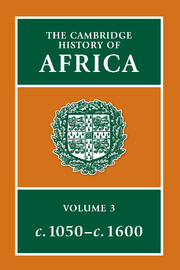Book contents
- Frontmatter
- Introduction: some interregional themes
- 1 Egypt, Nubia and the Eastern Deserts
- 2 Ethiopia, the Red Sea and the Horn
- 3 The East Coast, Madagascar and the Indian Ocean
- 4 The eastern Maghrib and the central Sudan
- 5 The western Maghrib and Sudan
- 6 Upper and Lower Guinea
- 7 Central Africa from Cameroun to the Zambezi
- 8 Southern Africa
- 9 The East African interior
- Bibliographical Essays
- Bibliography
- Index
- References
4 - The eastern Maghrib and the central Sudan
Published online by Cambridge University Press: 28 March 2008
- Frontmatter
- Introduction: some interregional themes
- 1 Egypt, Nubia and the Eastern Deserts
- 2 Ethiopia, the Red Sea and the Horn
- 3 The East Coast, Madagascar and the Indian Ocean
- 4 The eastern Maghrib and the central Sudan
- 5 The western Maghrib and Sudan
- 6 Upper and Lower Guinea
- 7 Central Africa from Cameroun to the Zambezi
- 8 Southern Africa
- 9 The East African interior
- Bibliographical Essays
- Bibliography
- Index
- References
Summary
A principal underlying theme for the central Sahara and Sudan in this chapter, in the period roughly from AD 1050 to 1600, is supplied by the basic pattern of penetration. New people, new ideas, new goods were crossing, or sometimes emerging from, the Sahara, and becoming established in the Sudan. There was considerable mobility, too, within the central Sudan itself, most dramatically illustrated by the exodus of the court of Kanem into Bornu about 1400. In the corresponding chapter in the next volume, concerned with the seventeenth and eighteenth centuries, it is more the tendency towards consolidation of states and societies which runs through the whole story.
The countries of the Sudan were by no means inactive partners in the trans-Saharan relationship. Sudanese gold was of critical importance for the Mediterranean economy; Sudanese slaves coloured the societies into which they were received. Even Islam, that most outstanding of all the gifts of the outside world to the Sudan in this early period, was influenced in its North African base by the beliefs and observances which these same slaves brought with them. Nevertheless, what was received in the Sudan countries had, on balance, a more profound historical influence than what was exported thence. Just what form this influence took in the Sudan depended upon the strengths and weaknesses, the needs and ambitions and preferences, of the receiving societies. And it is by rivetting our attention upon the local contribution that the new school of the historiography of black Africa has performed its most signal service.
- Type
- Chapter
- Information
- The Cambridge History of Africa , pp. 232 - 330Publisher: Cambridge University PressPrint publication year: 1977
References
- 7
- Cited by



